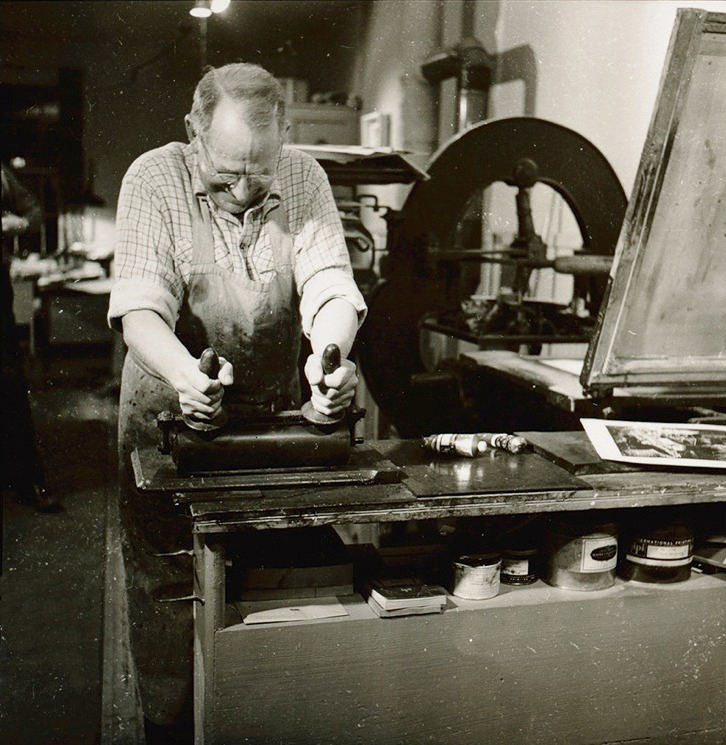Ellsworth gallery showcases Carroll Thayer Berry’s woodcut prints of Maine coast
Everyone has seen those idyllic depictions of coastal Maine in paintings and photographs. Brilliantly colorful lighthouses, sturdy pine trees and perfectly timed waves spraying up against the rocks — the ideal thing to hang in a summer visitor’s dining room, back in their year-round home in New Jersey or Florida.
And then there’s the work of Carroll Thayer Berry, whose stark, almost abstract take on the people and places along Maine’s coast exists in striking contrast to the picture-perfect landscapes up for sale in galleries from Ogunquit to Eastport.
Prints of Berry’s woodcut depictions of coastal Maine are on display for the month of March at the Courthouse Gallery in Ellsworth. The exhibit also offers an extremely rare opportunity for people to purchase the work of one of the most acclaimed Maine artists of the 20th century at affordable prices.
“The Emblematic Wood Engravings of Carroll Thayer Berry” features a number of Berry’s prints at prices starting at $275 — a fraction of the cost of similar 20th century Maine artists.
Those accessible prices are in keeping with Berry’s ethos. Despite the quality of his work and his formal artistic training, Berry, who died in 1978 at age 90, was a Mainer through and through. During the 1950s, he refused to sell any of his prints for more than $5 — roughly $50 in 2023. Fellow artists reportedly complained to him, saying they couldn’t compete with his prices.
“He started making prints during the Depression, because woodcut printing was a much more affordable medium than painting in that era,” said Sarah Lafontaine, who works for the Courthouse Gallery. “He sold a lot to summer people, but he also sold to locals.”
Berry was born in New Gloucester in 1886. Though his family wanted him to take over their dairy farm, he instead studied engineering at the University of Michigan. In 1910, he was sent to Panama to work on the building of the canal, where his artistic skills were quickly noticed and he later attended the Pennsylvania Academy of the Fine Arts.
After a stint working as a commercial artist in New York City, he enlisted during World War I and was assigned to the American Camouflage Corps, where alongside a number of other artists and designers, he created camouflage designs for soldiers in the field.
After the war, he and his wife lived in Chicago until the Great Depression hit, when they moved to Wiscasset. They would live in Maine for the rest of their lives.
It was in Maine that Berry found his artistic voice, using wood engraving, woodcut and linoleum block printmaking methods to depict the coast of Maine. All three types of printmaking involve carving or engraving an image into a block of wood or linoleum, rolling ink onto it and taking an impression or print.
Some of his prints are lyrical recreations of tiny fishing villages, shipyards and Maine landmarks such as Fort Knox or Old Fort Edgecomb. Others are more abstract, even severe, renderings of storms lashing the coast, or dilapidated old homes. They all have a distinctive style, unique to Berry and to the long history of artists interpreting the rocky coast of Maine.
Courthouse Gallery owners Karin and Michael Wilkes purchased a portion of Berry’s estate not long ago. Other collections of his work, including prints as well as drawings and photographs, can be found at the Center for Maine Contemporary Art, the Penobscot Marine Museum and the University of Maine, as well as at national institutions such as the National Gallery of Art and the Metropolitan Museum of Art.
Though most art lovers will be drawn to the fact that Berry depicted Maine, Lafontaine said his work belied a deeper, much more emotional core.
“His work was also very emotional. He had a lot of loss in his life, losing a son and later his wife. His later work is really very deeply emotional. He put a lot of himself in his work, even though he also loved Maine and everything in it,” she said.
 Carroll Thayer Berry in his studio.
Courtesy of the Penobscot Marine Museum
Carroll Thayer Berry in his studio.
Courtesy of the Penobscot Marine Museum